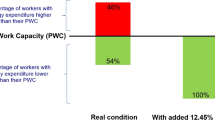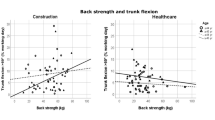Abstract
Purpose
To investigate changes of physical performance during long working hours and extended workweeks among construction workers with temporary accommodation in camps.
Methods
Nineteen construction workers with 12-h workdays and extended workweeks participated. Physical performance in the morning and evening of the second and eleventh workdays was tested by endurance, ability to react to a sudden load, flexibility of the back, handgrip strength and sub-maximal HR during a bicycle test. HR was registered throughout two separate workdays.
Results
HR during each of the two separate workdays corresponded to a relative workload of 25%. Sub-maximal HR was lower, reaction time faster and handgrip strength higher in the end of each test day. In the end of the work period, sub-maximal HR was lower, reaction time faster and sitting balance was better.
Conclusion
No trends of decreased physical performance were found after a workday or a work period.

Similar content being viewed by others
References
Åstrand I (1960) Aerobic work capacity in men and women with special reference to age. Acta Physiol Scand Suppl 169:1–92
Åstrand P-O, Ryhming I (1954) A nomogram for calculation of aerobic capacity (physical fitness) from pulse rate during submaximal work. J Appl Physiol 7:218–221
Axelsson J, Kecklund G, Akerstedt T, Lowden A (1998) Effects of alternating 8- and 12-hour shifts on sleep, sleepiness, physical effort and performance. Scand J Work Environ Health 24(Suppl 3):62–68
Biering-Sørensen F (1984) Physical measurements as risk indicators for low-back trouble over a one-year period. Spine 9:106–119
Bøggild H, Jeppesen HJ (2001) Intervention in shift scheduling and changes in biomarkers of heart disease in hospital wards. Scand J Work Environ Health 27:87–96
Bonjer FH (1971) Energy expenditure. In: Parmeggiani L (ed) Encyclopedia of occupational health and safety. International Labour Organisation, Geneva, pp 458–460
Borg V, Burr H (eds) (1997) Danske lønmodtageres arbejdsmiljø og helbred 1990–95. Arbejdsmiljøinstituttet, København
Cohen CJ, Muehl GE (1977) Human circadian rhythms in resting and exercise pulse rates. Ergonomics 20:475–479
Damlund M, Gøth S, Hasle P, Munk K (1986) Low back strain in Danish semi-skilled construction work. Appl Ergon 17:31–39
De zwart BCH, Frings-Dresen MHW, van Dijk FJH (1995) Physical workload and the ageing worker: a review of the literature. Int Arch Occup Environ Health 68:1–12
Dong X (2005) Long workhours, work scheduling and work-related injuries among construction workers in the United States. Scand J Work Environ Health 31:329–335
Engholm G, Holmström E (2005) Dose–response associations between musculoskeletal disorders and physical and psychosocial factors among construction workers. Scand J Work Environ Health 31:57–67
Essendrop M, Schibye B, Hansen K (2001) Reliability of isometric muscle strength tests for the trunk, hands and shoulders. Int J Ind Ergon 28:379–387
Essendrop M, Hye-Knudsen CT, Skotte J, Hansen AF, Schibye B (2003) Fast development of high intra-abdominal pressure when a trained participant is exposed to heavy sudden trunk loads. Spine 29:94–99
Faber A, Hansen K, Christensen H (2006) Muscle strength and aerobic capacity in a representative sample of employees with and without repetitive monotonous work. Int Arch Occup Environ Health 79:33–41
Fairfax AH, Balnave R, Adams RD (1995) Variability of grip strength during isometric contraction. Ergonomics 38:1819–1830
Garde AH, Faber A, Persson R, Hansen ÅM, Hjortskov N, Ørbæk P, Schibye B (2007) Concentrations of cortisol, testosterone and glycated haemoglobin (HbA1c) among construction workers with 12-hour workdays and extended workweeks. Int Arch Occup Environ Health 80:404–411
Gauvin MG, Riddle DL, Rothstein JM (1990) Reliability of clinical measurements of forward bending using the modified fingertip-to-floor method. Phys Ther 70:443–447
Hänecke K, Tiedemann S, Nachreiner F, Grzech-Sukalo H (1998) Accident risk as a function of hour at work and time of day as determined from accident data and exposure models for the German working population. Scand J Work Environ Health 24:43–48
Hannerz H, Spangenberg S, Tüchsen F, Albertsen K (2005) Disability retirement among former employees at the construction of the Great Belt Link. Public Health 119:301–304
Hartmann B, Fleischer AG (2005) Physical load exposure at construction sites. Scand J Work Environ Health 31:88–95
Ilmarinen J (1992) Job design for the aged with regard to decline in their maximal aerobic capacity: part II—the scientific basis for the guide. Int J Ind Ergon 10:65–77
Ilmarinen J, Ilmarinen R, Korhonen O, Nurminen M (1980) Circadian variation of physiological functions related to physical work capacity. Scand J Work Environ Health 6:112–122
Johnson MD, Sharit J (2001) Impact of a change from an 8-h to a 12-h shift schedule on workers and occupational injury rates. Int J Ind Ergon 27:303–319
Jørgensen K, Jensen B, Kato M (1991) Fatigue development in the lumbar paravertebral muscles of bricklayers during the working day. Int J Ind Ergon 8:237–245
Kecklund G, Åkerstedt T, Lowden A (1997) Morning work: effects of early rising on sleep and alertness. Sleep 20:215–223
Kecklund G, Ekstedt M, Åkerstedt T, Dahlgren A, Samuelson B (2001) The effects of double-shifts (15.5 hours) on sleep, fatigue and health. J Hum Ergol 30:53–58
Lees REM, Laundry BR (1989) Comparison of reported workplace morbidity in 8-hour and 12-hour shifts in one plant. Occup Med 39:81–84
Mathiesen K, Fløe T, Brendstrup T, Munk K, Hasle P, El-Salanti N (2003) Arbejdsmiljø, helbred og camps., Arbejdstilsynet. At-rapport 2
McGill S, Grenier S, Bluhm M, Preuss R, Brown S, Russell C (2003) Previous history of LBP with work loss is related to lingering deficits in biomechanical, physiological, personal, psychosocial and motor control characteristics. Ergonomics 46:731–746
Mitchell RJ, Williamson AM (2000) Evaluation of an 8 hour versus a 12 hour shift roster on employees at a power station. Appl Ergon 31:83–93
Nakanishi N, Yoshida H, Nagano K, Kawashimo H, Nakamura K, Tatara K (2001) Long working hours and risk for hypertension in Japanese male white collar workers. J Epidemiol Community Health 55:316–322
Persson R, Ørbæk P, Ursin H, Kecklund G, Österman K, Åkerstedt T (2003) Effects of the implementation of an 84-hour workweek on neurobehavioral test performance and cortisol responsiveness during testing. Scand J Work Environ Health 29:261–269
Rinne MB, Pasanen ME, Miilunpalo SI, Oja P (2001) Test–retest reproducibility and inter-rater reliability of a motor skill test battery for adults. Int J Sports Med 22:192–200
Rosa RR (1991) Performance, alertness, and sleep after 3, 5 years of 12 h shifts: a follow-up study. Work & Stress 5:107–116
Schibye B, Hansen AF, Søgaard K, Christensen H (2001) Aerobic power and muscle strength among young and elderly workers with and without demanding work tasks. Appl Ergon 32:425–431
Skotte JH, Fallentin N, Pedersen MT, Essendrop M, Strøyer J, Schibye B (2004) Adaptation to sudden unexpected loading of the low back—the effects of repeated trials. J Biomech 37:1483–1489
Skotte J, Hjortskov N, Essendrop M, Schibye B, Fallentin N (2005) Short latency stretch reflex in human lumbar paraspinal muscles. J Neurosci Methods 145:145–150
Suni JH, Oja P, Laukkanen RT, Miilunpalo SI, Pasanen ME, Vuori IM, Vartiainen TM, Bos K (1996) Health-related fitness test battery for adults: aspects of reliability. Arch Phys Med Rehabil 77:399–405
Tepas DI (1985) Flexitime, compressed workweeks and other alternative work schedules. In: Folkard S, Monk TH (eds) Hours of work. Wiley, London, pp 147–164
Tüchsen F, Hannerz H, Spangenberg S (2005) Mortality and morbidity among bridge and tunnel construction workers who worked long hours and long days constructing the Great Belt Fixed Link. Scand J Work Environ Health 31:22–26
van Dieën JH, Heijblom P (1996) Reproducibility of isometric trunk extension torque, trunk extensor endurance, and related electromyographic parameters in the context of their clinical applicability. J Orthop Res 14:139–143
Winget CM, Soliman MRI, Holley DC, Meylor JS (1992) Chronobiology of physical performance and sports medicine. In: Touitou Y, Haus E (eds) Biologic rhythms in clinical and laboratory medicine. Springer, Berlin, pp 230–255
Yamada Y, Kameda M, Noborisaka Y, Suzuki H, Honda M, Yamada S (2001) Excessive fatigue and weight gain among cleanroom workers after changing from an 8-hour to a 12-hour shift. Scand J Work Environ Health 27:318–326
Acknowledgments
The project was financed by a special bill “Satspuljen 1999, pt. 6” from Folketinget, The Danish Parliament: account FS 17.21.05.30. Contractors for the bill were Centre for Alternative Social Analysis and Carl Bro A/S. The authors declare that they have no conflict of interest.
Author information
Authors and Affiliations
Corresponding author
Rights and permissions
About this article
Cite this article
Faber, A., Strøyer, J., Hjortskov, N. et al. Changes in physical performance among construction workers during extended workweeks with 12-hour workdays. Int Arch Occup Environ Health 83, 1–8 (2010). https://doi.org/10.1007/s00420-009-0471-0
Received:
Accepted:
Published:
Issue Date:
DOI: https://doi.org/10.1007/s00420-009-0471-0




